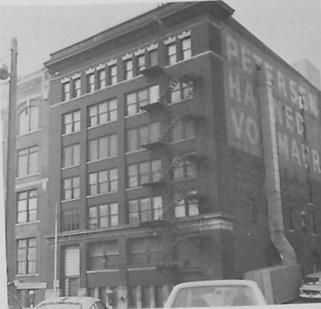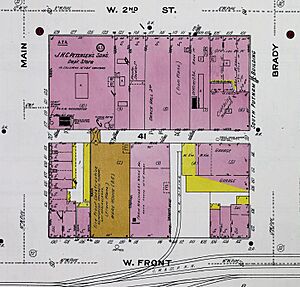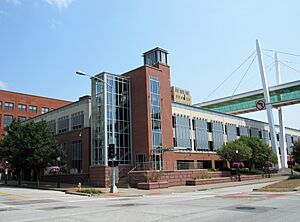Schick's Express and Transfer Co. facts for kids
|
Schick's Express and Transfer Co.
|
|
|
Formerly listed on the U.S. National Register of Historic Places
|
|

Schick's Express and Transfer Co. building
|
|
| Location | 118-120 W. River Dr. Davenport, Iowa |
|---|---|
| Built | 1905 |
| Architect | Clausen & Clausen |
| Architectural style | Early Commercial |
| MPS | Davenport MRA |
| NRHP reference No. | 83002497 |
Quick facts for kids Significant dates |
|
| Added to NRHP | July 7, 1983 |
| Removed from NRHP | December 19, 2014 |
The Schick's Express and Transfer Co. was a building in downtown Davenport, Iowa. It was added to the National Register of Historic Places in 1983. This register is a list of places in the United States that are important to history. The building later became part of a large department store complex.
What Was Schick's Express and Transfer Co.?
Schick's Express and Transfer Company built this warehouse in 1905. It was their main office and storage building. The company moved goods and packages for people and businesses.
The building was on Front Street, which is now called River Drive. It was close to the Chicago, Milwaukee, St. Paul and Pacific Freight House. This location was great for moving things. It allowed easy access to trains and other ways to transport goods.
How the Building Changed Over Time
Later, a big department store called Petersen, Harned, and Von Maur bought the building. They used it as a warehouse to store their products.
In the early 2000s, the Schick's Express building was torn down. The nearby J.H.C. Petersen's Sons Wholesale Building was also removed. This was done to build a new parking garage and the Davenport Skybridge. Because the building was no longer there, it was removed from the National Register of Historic Places in 2014.
What Did the Building Look Like?
The Schick's Express and Transfer Co. building was an example of early Commercial architecture. This style was popular in cities like Chicago. It was one of the few buildings in Davenport that had many large windows. These windows showed the strong structure underneath the brick walls.
The building looked quite simple. It did not have many fancy decorations. The only special parts were a metal cornice (a decorative top edge). It also had rustication (rough-looking stone blocks) at the corners. Stone arches above the windows added a simple touch.





